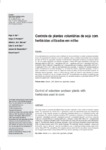Please use this identifier to cite or link to this item:
http://www.alice.cnptia.embrapa.br/alice/handle/doc/897766| Title: | Controle de plantas voluntárias de soja com herbicidas utilizados em milho. |
| Authors: | DAN, H. A.  PROCOPIO, S. de O.   BARROSO, A. L. de L.   DAN, L. G. de M.   OLIVEIRA NETO, A. M.   GUERRA, N.   |
| Affiliation: | HUGO A. DAN, UNIVERSIDADE ESTADUAL DE MARINGÁ SERGIO DE OLIVEIRA PROCOPIO, CNPMA ALBERTO L. DE L. BARROSO, UNIVERSIDADE DE RIO VERDE LILIAN G. DE M. DAN, UNIVERSIDADE ESTADUAL DE MARINGÁ ANTONIO M. OLIVEIRA NETO, UNIVERSIDADE ESTADUAL DE MARINGÁ NAIARA GUERRA, UNIVERSIDADE ESTADUAL DE MARINGÁ. |
| Date Issued: | 2011 |
| Citation: | Revista Brasileira de Ciências Agrárias, Recife, v. 6, n. 2, p. 253-257, 2011. |
| Description: | O presente trabalho teve por objetivo avaliar a eficiência de diversos herbicidas no controle de plantas voluntárias de soja. O experimento foi conduzido em casa de vegetação, onde as unidades experimentais foram compostas de vasos de 10 dm3 de capacidade, dispostos em delineamento inteiramente casualizado em esquema fatorial 2 x 12, com quatro repetições. As cultivares Conquista e Valiosa RR® foram submetidas à aplicação dos herbicidas: atrazine (1.500 g ha-1), tembotrione (100 g ha-1), mesotrione (120 g ha-1), nicosulfuron (40 g ha-1), 2,4-D (670; 1.050 e 1.340 g ha-1), diquat (300 g ha-1), paraquat (400 g ha-1), [paraquat + diuron] (500 + 250 g ha-1) e glyphosate (1.500 g ha-1), além de uma testemunha sem aplicação. A aplicação foi realizada quando as plantas encontravam-se no estádio fenológico V3. Os herbicidas atrazine, glyphosate, [paraquat + diuron] e diquat apresentaram os maiores níveis de controle das plantas voluntárias de soja da variedade Conquista. Os herbicidas atrazine, [paraquat + diuron] e 2,4-D na dose de 1.340 g ha-1 foram os mais eficientes no controle das plantas voluntárias de soja da variedade Valiosa RR®. A suscetibilidade das plantas voluntárias de soja provenientes da variedade convencional (Conquista) e da variedade resistente ao glyphosate (Valiosa RR®) foi variável de acordo com o herbicida aplicado. Control of volunteer soybean plants with herbicides used in corn. This study aimed at evaluating the effectiveness of several herbicides on the control of volunteer soybean plants. The experiment was carried out in a greenhouse, where the experimental units were composed of vessels with 10 dm3 capacity, arranged in a completely randomized design, in a 2 x 12 factorial scheme, with four replications. The cultivars Conquista and Valiosa RR® underwent an application of the herbicides: atrazine (1.500 g ha-1), tembotrione (100 g ha-1), mesotrione (120 g ha-1), nicosulfuron (40 g ha-1), 2.4 D (670; 1,050 and 1,340 g ha-1), diquat (300 g ha-1), paraquat (400 g ha-1), [paraquat + diuron] (500 + 250 g ha-1), and glyphosate (1,500 g ha-1), besides an untreated control. The application was made when the plants were in the phenological stage V3. The herbicides atrazine, glyphosate, [paraquat + diuron] and diquat showed the highest control levels of the volunteer soybean plants of the variety Conquista. The herbicides atrazine, [paraquat + diuron] and 2.4-D at the dose of 1,340 g ha-1 were the most effective ones in controlling volunteer soybean plants of the cultivar Valiosa RR®. The susceptibility of the volunteer soybean plants from the conventional variety (Conquista) and the glyphosate-resistant variety (Valiosa RR®) was variable depending on the applied herbicide. |
| Thesagro: | Soja Milho Herbicida Erva daninha |
| NAL Thesaurus: | Volunteer plants Weeds Soybeans Corn Herbicides |
| Keywords: | Planta voluntaria Planta tiguera |
| DOI: | 10.5039/agraria.v6i2a1032 |
| Type of Material: | Artigo de periódico |
| Access: | openAccess |
| Appears in Collections: | Artigo em periódico indexado (CNPSO)  |
Files in This Item:
| File | Description | Size | Format | |
|---|---|---|---|---|
| DANCONTROLE.pdf | 46.07 kB | Adobe PDF |  View/Open |









